A command-by-command walkthrough of Name Mangler's menu structure. Note that standard macOS menu items, such as or won't be explained—we assume you know your way around the basic Mac interface.
Name Mangler
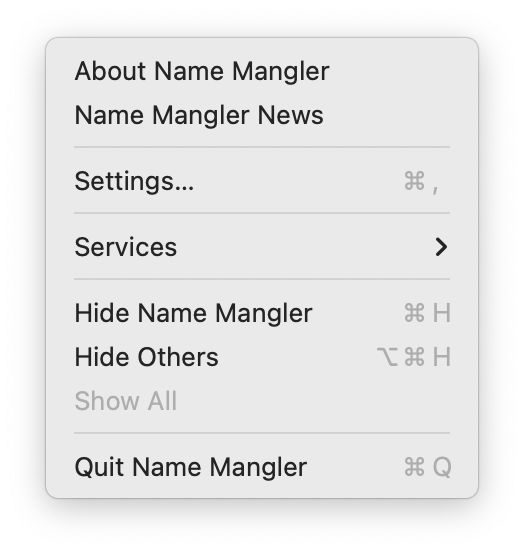
The about box, which contains the version number and build number (which may occasionally be useful when corresponding with Many Tricks).
Displays a box with the latest information about Name Mangler, including release notes and support information. (This menu item only appears in the App Store version of Name Mangler.)
Open Name Mangler's Settings window. Please read the Settings section for a full explanation of these settings.
File
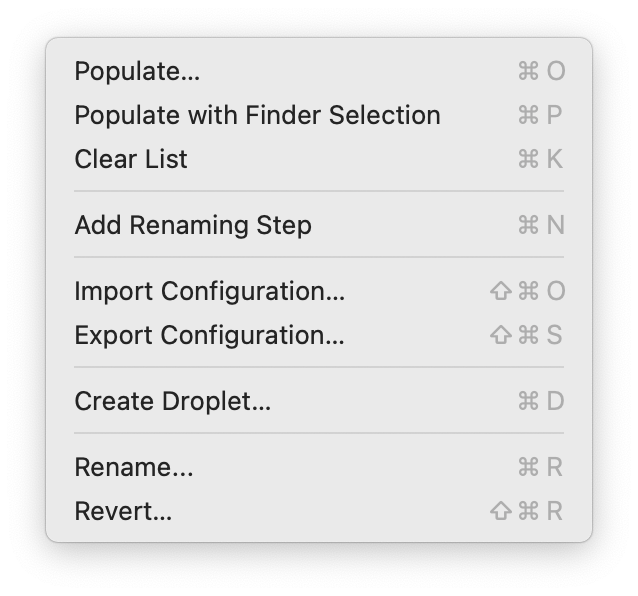
Presents a standard macOS "open file" dialog, from which you can choose the files you wish to rename.
If you've selected a number of files in Finder, this menu item will use them to populate the list of files to be renamed. If you're an App Store customer, please see the note related to this feature in the Tips and Tricks chapter.
If you're a Path Finder user, hold down the Option key to change this menu item to Populate with Path Finder Selection. This feature is only available in the non App Store version of Name Mangler.
Blank the list of files in Name Mangler.
Create, or add to, a multi-step configuration, by adding a new renaming action.
and If you use Name Mangler on multiple Macs, or if you want to share a particular renaming setup with another Mac user, these are the menu items you'll want to use. First create your renaming action, then export a configuration from that Mac, move the resulting file to the other Mac, and then use Import Configuration (or double-click the .nma file) to load the saved configuration.
If you'd like to change Name Mangler's default renaming action—which is Find and Replace—here's all you need to do…
- Select the action that you'd like to be the default—Sequence, Add Suffix, Advanced, whatever. You can even set up more than one action; if you always do a Find and Replace followed by a Sequence action, then set up both those steps.
- Hold down the Option key, then select → from the menu bar.
That's it, there is no step three. The next time you launch Name Mangler, it will load with your defined configuration. If you ever want the default back, just hold down Option and select → .
Create a reusable mini-application that lets you perform a given renaming configuration via drag-and-drop. See Droplets for more on using droplets.
An important note about creating renaming services: Older versions of macOS allowed Name Mangler to create renaming services (available from the Services contextual menu in Finder) directly within Name Mangler—and you'd find the menu item to do that right here in the File menu.
Sadly, changes in macOS mean this is no longer possible, but you can still create Name Mangler renaming Quick Actions with the help of Name Mangler's Droplets and Automator. For full details on that process, please read How to create Name Mangler Services on our blog. There you'll find detailed walkthroughs of the process, in both text and visual formats.
Execute the current renaming action on some number (nn) of files.
Undo the last-executed renaming action.
You can only revert the last-performed renaming action, and only if you haven't manipulated the files since the renaming (and haven't cleared Name Mangler's file list).
Edit
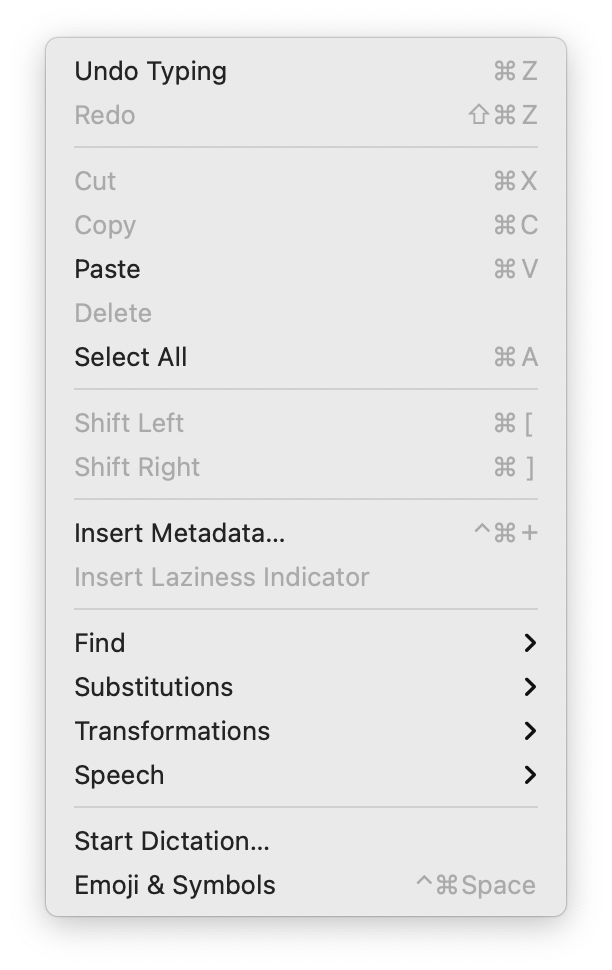
This is the standard macOS Edit menu, with a few Name Mangler specific items, which are:
and When working in Name Mangler's Advanced mode, you can use these commands to decrease (Shift Left) and increase (Shift Right) the indent for the currently selected lines.
Brings up Name Mangler's metadata selector, for including file metadata in renaming operations. See Using Metadata for details on Name Mangler's metadata support.
Only available when the Sequence action's Group by field is active (i.e. has been clicked into). When selected, any sequences that would affect only one file will instead have no sequence number appended. This lets you, for example, make it so that folders with only one file in them don't get a sequence number appended when you're grouping by name of parent folder. The laziness indicator is a bed (bed…lazy…get it?), and it looks like this:

You can remove the laziness indicator by deleting it, just like you would any other text in an input box.
View
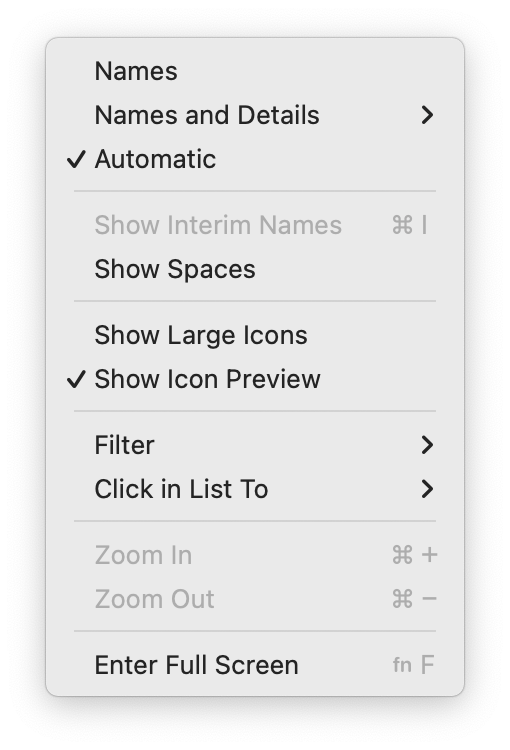
The view menu is primarily used to control the appearance of entries in the file area of Name Mangler's window. The first three entries control how much detail you see for each file in the list.
Display just the filename.
In addition to the filename, display a line of information about each file. This menu item opens a sub-menu, containing the options for the additional information line. What's displayed on that line is controlled by the Names and Details sub-menu:
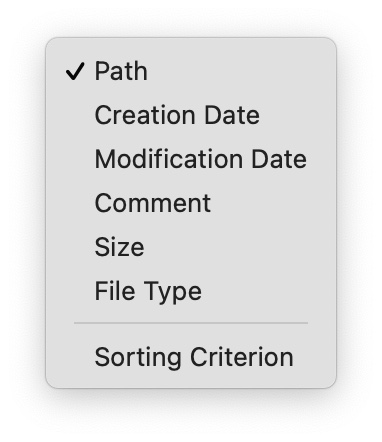
By default, the displayed information line will be based on the sort criteria ( is selected); sort by size, for example, and you'll see the file size displayed. You can choose any of the other detail modes, though, simply by selecting them from this sub-menu.
With the menu option (see below) set to , clicking on any file will change the detailed information displayed—each click will cycle to the next available data type, in this order:
Path → Creation Date → Modification Date → Comment → Size → Extension, Type, and Creator
Hold down the Shift key to change the displayed detail line for all files.
When the file list is sorted (see Interface) by Names, Shuffle, or Manual, only filenames will be displayed (that is, Names view mode will be used). All other sorts will use 'Names and Details' mode.
With a multi-step renaming process, display a column showing the names as of the selected step in the process. Can also be useful in some single-step renaming tasks. (See the File Info Area section of help for more on interim names.)
When enabled, spaces are marked in two different methods. Individual spaces are denoted by a small diamond icon in the filename, while leading, trailing, and double-spaces get an additional color callout. Here's how space highlighting looks in each of Name Mangler's appearance modes:

When in Names or Automatic mode, use larger icons, as seen in the screenshot above.
When checked, display the file's preview icon; otherwise, display the icon for the document type.
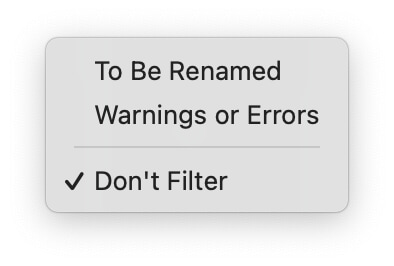 Opens a submenu (as seen in the image at right) that controls what you see in Name Mangler's file list area.
Opens a submenu (as seen in the image at right) that controls what you see in Name Mangler's file list area.
By default, Name Mangler shows all files in the file list area (Don't Filter is selected). If you select To Be Renamed, only those files or folders whose names will be changed by the current renaming action will be visible in the list. Similarly, selecting Warnings or Errors will show only those files or folders that won't be renamed due to errors and warnings.
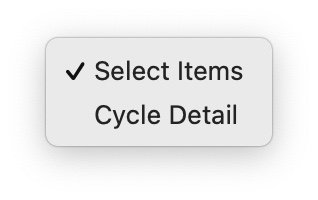 This setting controls the behavior of the file list area. Select it, and you'll see a sub-menu with two options, as seen in the image at right.
This setting controls the behavior of the file list area. Select it, and you'll see a sub-menu with two options, as seen in the image at right.
When set to "Select Items," which is the default, the file list area behaves much like Finder:
- Click, Shift-click, and Command-click to select one or more files.
- With one ore more files selected, pressing Delete will remove them from the list of files to be renamed.
- If you copy and paste a selection of files, they will become the files in the file list area.
At no time will any of the copy or delete operations you perform in Name Mangler affect your actual files. You are simply working with the list of files to be modified. Again, Name Mangler will not delete your files if you highlight a selection of them and press Delete. The "deleted" files are simply removed from the list of files to be renamed.
If you set this pop-up to "Cycle Detail," clicking on a file will cycle through the available details for that file. (See "Names and Details" above for more information on how this works.)
and These two options will be disabled unless you're viewing Name Mangler's help file, in which case they can be used to zoom in and out of the text.
Switch to macOS's full screen mode.
History
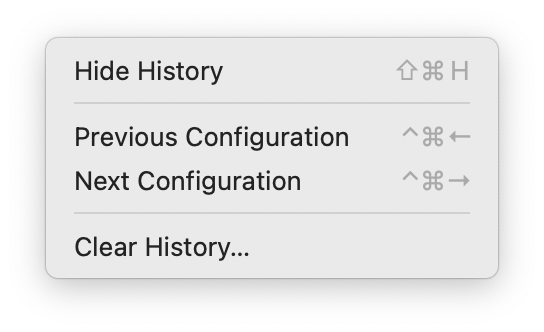
Name Mangler remembers your previously-used renaming configurations; these are managed through the History menu. To change how many configurations Name Mangler remembers, use the History pop-up in Settings.
or Selecting this item has the same effect as clicking on the History button in Name Mangler's window: it toggles the visibility of Name Mangler's history browser:
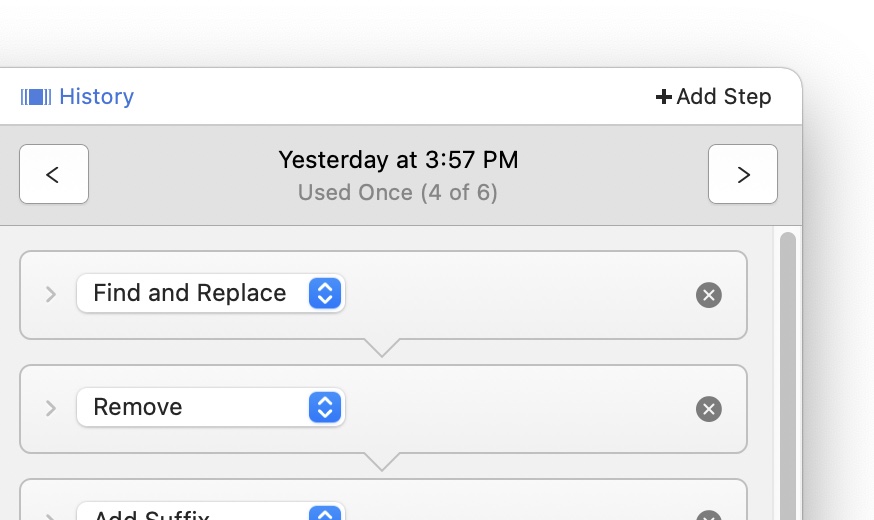
The history browser makes it simple to reuse any previously-used renaming action.
and —and their associated keyboard shortcuts—let you easily browse your renaming history. These menu items replicate the functionality of the back and forward arrows in the history browser.
If you hold down the Shift key, these menu items change to and , letting you easily jump to the start or end of your renaming history.
Clears your history. There is no undo for this operation, so be certain that you want it gone before you choose it. (You will get a confirmation dialog before the clearing takes place.)
Presets
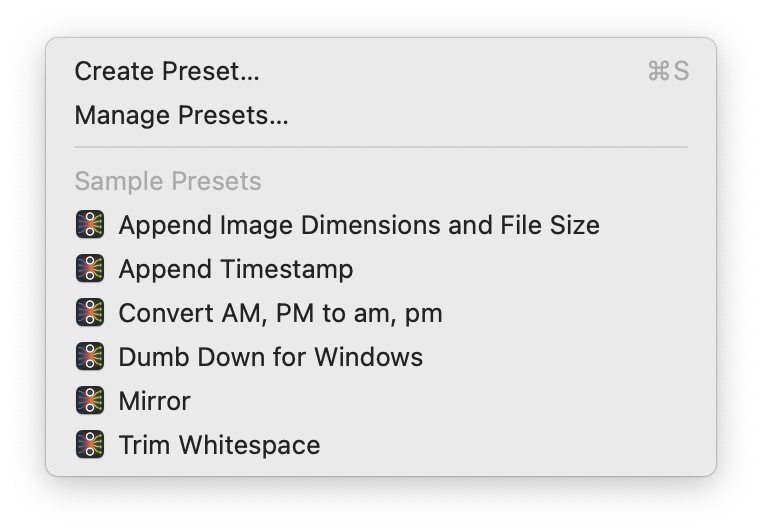
Presets are somewhat like History, except that you can create and save a preset without executing a renaming action. As shipped, Name Mangler includes a few sample presets; feel free to use these, or remove them if you don't need them.
Creates a new preset, using the renaming configuration currently displayed in Name Mangler.
Opens a Finder window displaying the Presets folder, which allows you to rename a preset. Your name changes will be reflected in Name Mangler as soon as you switch back to the application.
You can delete presets from within Name Mangler (or from Finder, obviously). Hold down the Option key when selecting the Presets menu item, and the entry for each saved preset will change:
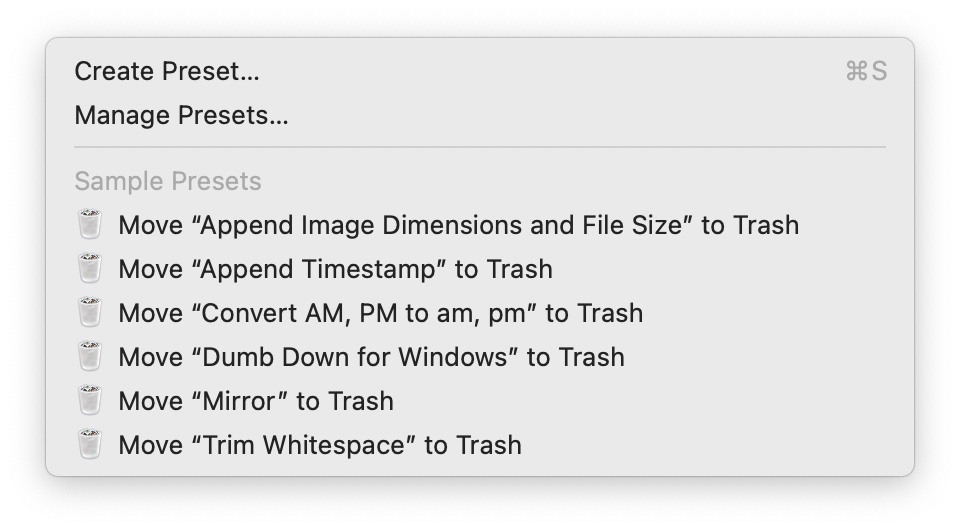
Note that you can change the location of the saved presets in Name Mangler's Settings.
If you set the location for presets and snippets to a Dropbox, Box, or similar synchronized folder, you can share your snippets and presets across all instances of Name Mangler. Just change the preference in each copy of the program to point to that same folder.
See the Presets section of help for more information on creating and using presets.
Window
This is the standard macOS window menu helps you work with the Name Mangler's window. You're probably really familiar with this menu by now, and there's nothing here that's unique to Name Mangler. (Well, OK, is unique to us, but you can probably figure out what that one does without any explanation.)
Help

The standard macOS Help menu. Select to open this help file, and use to send us feedback (bug reports, feature requests, etc.) via your email client.
You can use the Search box to find Name Mangler menu items. Just start typing some portion of the menu item's name, and you'll see matches displayed in real time. Select the one you want to use, and you're done.

